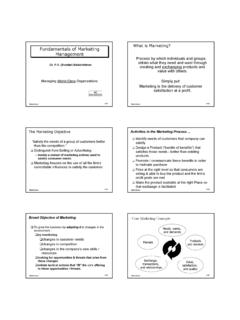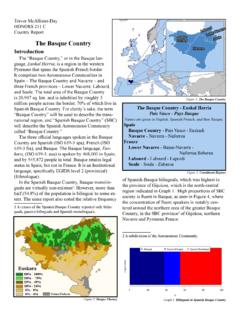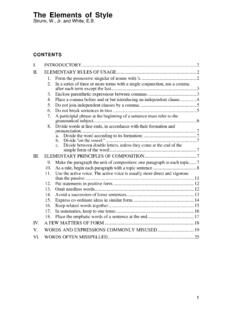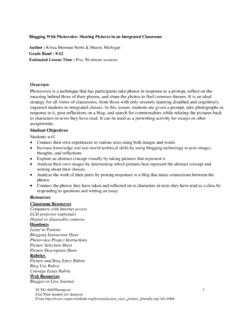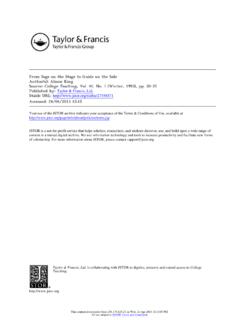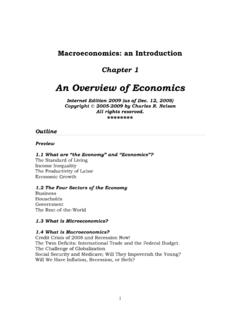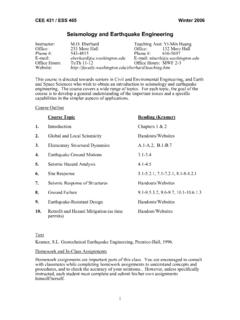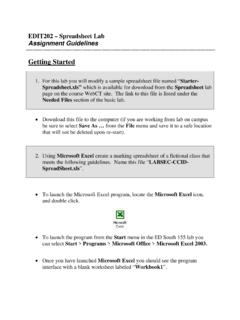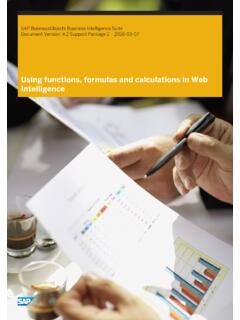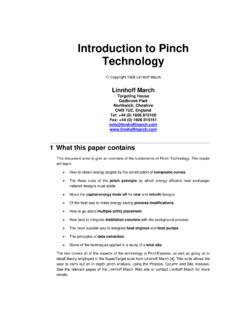Transcription of Formulating Linear Programming Models
1 Session #4 Page 1 Formulating Linear Programming Models Formulating Linear Programming Models Some Examples: Product Mix (Session #2) Cash Flow (Session #3) Diet / Blending Scheduling Transportation / Distribution Assignment Steps for Developing an Algebraic LP model 1. What decisions need to be made? Define each decision variable. 2. What is the goal of the problem? Write down the objective function as a function of the decision variables. 3. What resources are in short supply and/or what requirements must be met? Formulate the constraints as functions of the decision variables. Steps for Developing an LP model in a Spreadsheet 1. Enter all of the data for the model . Make consistent use of rows and columns . 2. Make a cell for each decision to be made (changing cells). Follow the same structure as the data. (Sometimes it is easier to do step 2 before step 1.) 3. What is the goal of the problem?
2 Enter the equation that measures the objective in a single cell on the worksheet (target cell). Typically: SUMPRODUCT (Cost Data, Changing Cells) or SUMPRODUCT (Profit Data, Changing Cells) 4. What resources are in short supply and/or what requirements must be met? Enter all constraints in three consecutive cells on the spreadsheet, , amount of resource used , <= , amount of resource available Session #4 Page 2 Formulating Linear Programming Models or amount attained , >= , minimum requirement Session #4 Page 3 Formulating Linear Programming Models LP Example #1 (Diet Problem) A prison is trying to decide what to feed its prisoners. They would like to offer some combination of milk, beans, and oranges. Their goal is to minimize cost, subject to meeting the minimum nutritional requirements imposed by law. The cost and nutritional content of each food, along with the minimum nutritional requirements are shown below.
3 Milk (gallons) Navy Beans (cups) Oranges (large Calif. Valencia) Minimum Daily Requirement Niacin (mg) Thiamin (mg) Vitamin C (mg) Cost ($) Session #4 Page 4 Formulating Linear Programming Models A Spreadsheet model for LP Example #1 123456789101112131415 ABCDEFGHThe Prison Diet ProblemMilkBeans(gal.)(cups)OrangesCost$ $ $ Contents (mg)TotalRequirementNiacin (mg) >=13 Thiamin (mg) >= C (mg)3209345>=45 Total $ (per prisoner) 3456789101112131415 BCDEFGHMilkBeans(gal.)(cups) Contents (mg)TotalRequirementNiacin (mg) (C9:E9,$C$14:$E$14)>=13 Thiamin (mg) (C10:E10,$C$14:$E$14)>= C (mg)32093=SUMPRODUCT(C11:E11,$C$14:$E$14 )>=45 Total (C5:E5,C14:E14)(per prisoner) Session #4 Page 5 Formulating Linear Programming Models Diet/Menu Planning model in Practice George Dantzig s Diet Stigler (1945) The Cost of Subsistence Dantzig invents the simplex method (1947) Stigler s problem solved in 120 man days (1947) Dantzig goes on a diet (early 1950 s), applies diet model : o 1500 calories o objective.
4 Maximize (weight minus water content) o 500 foods Initial solutions had problems (500 gallons of vinegar, 200 bouillon cubes) (for more details, see July-Aug 1990 Interfaces article The Diet Problem , available for download at under Published Issues ) Least-Cost Menu Planning Models in Food Systems Management Used in many institutions with feeding programs: hospitals, nursing homes, schools, prisons, etc. Menu planning often extends to a sequence of meals or cycle Variety important (separation constraints) Preference ratings (related to service frequency) Side constraints (color, categories, etc.) Generally Models have reduced cost about 10%, meet nutritional requirements better, and increased customer satisfaction compared to traditional methods USDA uses these Models to plan food stamp allotment (for more details, see Sept-Oct 1992 Interfaces article The Evolution of the Diet model in Managing Food Systems , available for download at under Published Issues ) Session #4 Page 6 Formulating Linear Programming Models LP Example #2 (Scheduling Problem) Time Period Number of Officers Needed 12 - 4 5 4 - 8 7 8 - 12 15 12 - 4 8 4 - 8 12 8 - 12 9 Union contract requires all employees to work 8 consecutive hours.
5 Goal: Hire the minimum number of officers needed to cover all shifts. Session #4 Page 7 Formulating Linear Programming Models A Spreadsheet model for LP Example #2 1234567891011121314 ABCDEFGHIJKS ecurity Force Scheduling ProblemShift 1 Shift 2 Shift 3 Shift 4 Shift 5 Shift 6 NumberMinimumTime Period12a 8a4a 12p8a 4p12p 8p4p 12a8p 4aWorkingRequired12am 4am115>=54am 8am1112>=78am 12pm1115>=1512pm 4pm118>=84pm 8pm1112>=128pm 12am1112>=9 TotalNumber Working578012032 Shift Works Time Period? 34567891011121314 BCDEFGHIJKS hift 1 Shift 2 Shift 3 Shift 4 Shift 5 Shift 6 NumberMinimumTime Period12a 8a4a 12p8a 4p12p 8p4p 12a8p 4aWorkingRequired12am 4am11=SUMPRODUCT(C6:H6,$C$14:$H$14)>=54a m 8am11=SUMPRODUCT(C7:H7,$C$14:$H$14)>=78a m 12pm11=SUMPRODUCT(C8:H8,$C$14:$H$14)>=15 12pm 4pm11=SUMPRODUCT(C9:H9,$C$14:$H$14)>=84p m 8pm11=SUMPRODUCT(C10:H10,$C$14:$H$14)>=1 28pm 12am11=SUMPRODUCT(C11:H11,$C$14:$H$14)>= 9 TotalNumber Working5780120=SUM(C14:H14)Shift Works Time Period?
6 Session #4 Page 8 Formulating Linear Programming Models Workforce Scheduling model in Practice United Airlines in the 1980 s Employ 5000 reservation and customer service agents Some part time (2-8 hr shifts), some full time (8-10 hour shifts) Workload varies greatly over day Modeled problem as LP: o Decision variables: how many employees of each shift length should begin at each potential start time (half-hour intervals). o Constraints: minimum required employees for each half-hour o Objective: minimize cost Saved UA about $6 million annually, improved customer service, still in use today. (for more details, see Jan-Feb 1986 Interfaces article United Airlines Station Manpower Planning System , available for download at under Published Issues ) Session #4 Page 9 Formulating Linear Programming Models LP Example #3 (Transportation Problem) A company has two plants producing a certain product that is to be shipped to three distribution centers.
7 The unit production costs are the same at the two plants, and the shipping cost per unit is shown below. Distribution Center 1 2 3 Plant A $4 $6 $4 B $6 $5 $2 Shipments are made once per week. During each week, each plant produces at most 60 units and each distribution center needs at least 40 units. How many units should be shipped from each plant to each distribution center, so as to minimize cost? Session #4 Page 10 Formulating Linear Programming Models Spreadsheet model for LP Example #3 1234567891011121314151617 ABCDEFGHA Distribution ProblemDistributionDistributionDistribut ionCostCenter 1 Center 2 Center 3 Plant A$4$6$4 Plant B$6$5$2 ShipmentDistributionDistributionDistribu tionQuantitiesCenter 1 Center 2 Center 3 ShippedAvailablePlant A4020060<=60 Plant B0204060<=60 Shipped404040>=>=>=Total CostNeeded404040$460 34567891011121314151617 BCDEFGHD istributionDistributionDistributionCostC enter 1 Center 2 Center 3 Plant A464 Plant B652 ShipmentDistributionDistributionDistribu tionQuantitiesCenter 1 Center 2 Center 3 ShippedAvailablePlant A40200=SUM(C13:E13)<=60 Plant B02040=SUM(C14:E14)<=60 Shipped=SUM(C13:C14)=SUM(D13:D14)=SUM(E13:E14)>=>=>=Total CostNeeded404040=SUMPRODUCT(C5:E6,C13.)
8 E14) Session #4 Page 11 Formulating Linear Programming Models Designing a Distribution System for Entire Product Line (Proctor and Gamble) Proctor and Gamble in early 90 s Needed to consolidate and re-design their North American distribution system: o 50 product categories o 60 plants o 15 distribution centers o 1000 customer zones Solved many transportation problems (1 for each product category) Goal: find best distribution plan, which plants to keep open, etc. Saved $200 million per year. (for more details, see 1997 Jan-Feb Interfaces article, Blending OR/MS, Judgement, and GIS: Restructuring P&G s Supply Chain , available for download at under Published Issues ) Session #4 Page 12 Formulating Linear Programming Models LP Example #4 (Assignment Problem) The coach of a swim team needs to assign swimmers to a 200-yard medley relay team (four swimmers, each swims 50 yards of one of the four strokes).
9 Since most of the best swimmers are very fast in more than one stroke, it is not clear which swimmer should be assigned to each of the four strokes. The five fastest swimmers and their best times (in seconds) they have achieved in each of the strokes (for 50 yards) are Backstroke Breaststroke Butterfly Freestyle Carl Chris David Tony Ken How should the swimmers be assigned to make the fastest relay team? Session #4 Page 13 Formulating Linear Programming Models Spreadsheet model for LP Example #4 12345678910111213141516171819 ABCDEFGHIAn Assignment ProblemBest <=1 Chris00101<=1 David10001<=1 Tony01001<=1 Ken00000<=11111==== 345678910111213141516171819 BCDEFGHIBest (C12:F12)<=1 Chris0010=SUM(C13:F13)<=1 David1000=SUM(C14:F14)<=1 Tony0100=SUM(C15:F15)<=1 Ken0000=SUM(C16:F16)<=1=SUM(C12:C16)=SUM (D12:D16)=SUM(E12:E16)=SUM(F12:F16)====T ime1111=SUMPRODUCT(C4:F8,C12:F16)
